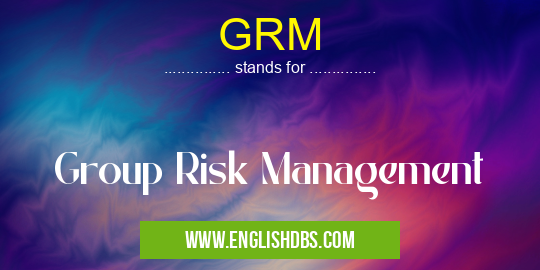What does GRM mean in MANAGEMENT
Group Risk Management (GRM) is a comprehensive approach to managing risks within an organization. It involves identifying, assessing, and mitigating potential threats to an organization's assets, reputation, and overall performance.

GRM meaning in Management in Business
GRM mostly used in an acronym Management in Category Business that means Group Risk Management
Shorthand: GRM,
Full Form: Group Risk Management
For more information of "Group Risk Management", see the section below.
» Business » Management
What does GRM Stand for?
GRM stands for Group Risk Management. It is a framework that helps organizations manage risks across all departments and units within a business.
Key Components of GRM
- Risk Identification: Identifying potential risks that could impact the organization.
- Risk Assessment: Evaluating the likelihood and severity of identified risks.
- Risk Mitigation: Developing and implementing strategies to reduce or eliminate identified risks.
- Risk Monitoring: Regularly reviewing and updating risk assessments and mitigation plans.
- Risk Communication: Sharing risk information and mitigation plans with stakeholders.
Benefits of GRM
- Improved decision-making based on sound risk analysis.
- Enhanced protection of organizational assets and reputation.
- Increased agility and adaptability in the face of changing risks.
- Improved compliance with regulatory and industry standards.
- Reduced financial losses and operational disruptions.
Essential Questions and Answers on Group Risk Management in "BUSINESS»MANAGEMENT"
What is Group Risk Management (GRM)?
Group Risk Management (GRM) is a holistic approach to identifying, assessing, and mitigating risks faced by a group of related companies or entities. It involves developing and implementing policies and procedures to manage risks across the entire group, ensuring consistency and coordination among its members.
Why is GRM important?
GRM is important because it helps organizations:
- Enhance risk oversight and decision-making
- Improve risk identification and mitigation
- Foster a culture of risk awareness
- Comply with regulatory requirements
- Protect the group's reputation and financial stability
What are the key elements of GRM?
Key elements of GRM include:
- Risk identification and assessment
- Risk mitigation and control
- Risk monitoring and reporting
- Risk culture and governance
- Risk appetite and tolerance
How does GRM differ from enterprise risk management (ERM)?
While both GRM and ERM focus on managing risks, GRM is specifically designed for organizations with multiple entities or subsidiaries. GRM considers the unique risks and interdependencies within the group, while ERM focuses on the risks faced by an individual entity.
What are the benefits of implementing GRM?
Benefits of implementing GRM include:
- Improved risk visibility and management
- Enhanced regulatory compliance
- Reduced operational costs
- Protected reputation and brand
- Increased shareholder value
Final Words: GRM is an essential component of effective business management. By adopting a comprehensive approach to risk management, organizations can proactively address potential threats, protect their interests, and achieve their strategic goals.
GRM also stands for: |
|
| All stands for GRM |
